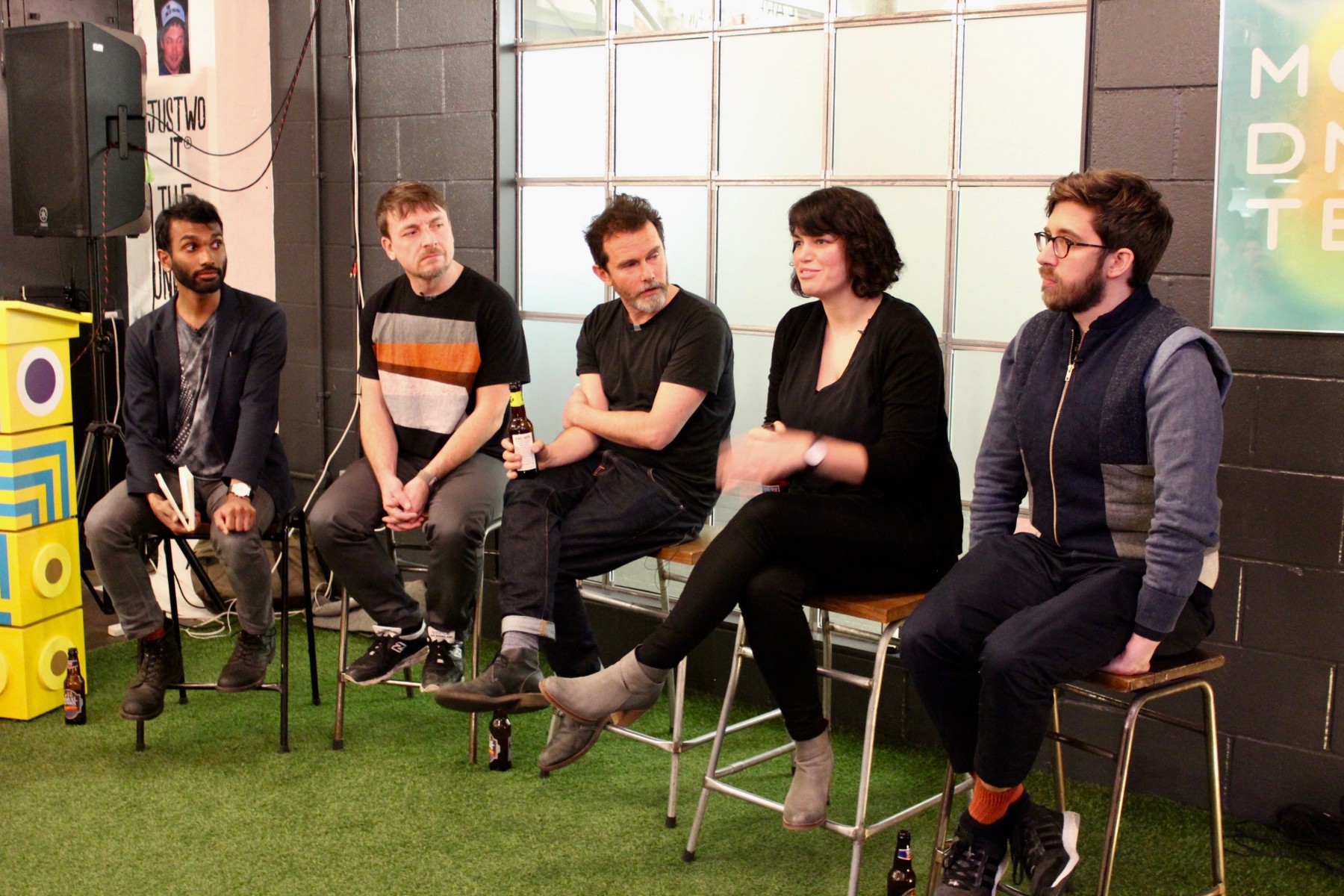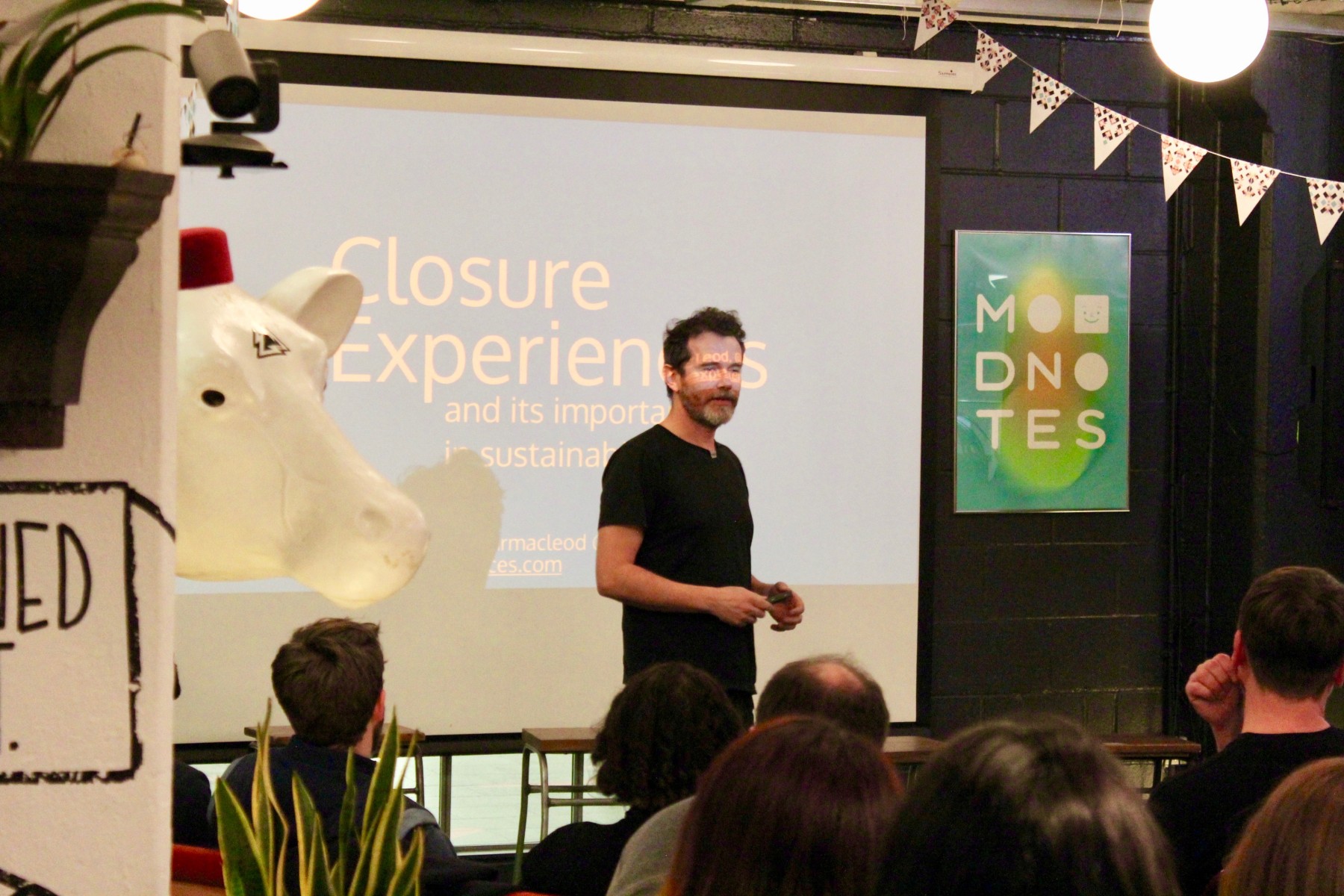For the first in a series of design-focused ustwoTALKIES, we gathered in the London studio to explore the messy intersection between our digital world and the environment – and what this means for designers. You can listen to whole evening in our podcast here or keep reading for the digested version.
Embedded content: https://soundcloud.com/ustwo-fm/ustwotalkies-designing-for-sustainability
We convened some digital design trailblazers to talk about the importance of considering environmental, cultural and societal impact when creating products. Alex Crowfoot, ustwo’s Head of Product and Discovery, served up some environmental home truths in his talk ‘Designing for Yesterday’ – as well as delivering practical advice on how to get sustainability onto your client's agenda. We then turned to Joe Macleod for his insights into digital landfill and creating more valuable closure experiences.
Our two speakers then joined a panel with Dr Leila Sheldrick, Unmade co-founder Ben Alun-Jones and compére Aran Dasan to talk more generally about the opportunities and pitfalls of sustainable design. They shared their experiences and anecdotes, as well as fielding some tough questions from the audience, to deliver a convincing argument for why all of us need to be adopting a more conscious design practice.

Designing For Yesterday
After an introduction from ustwo Design Director Helen Fuchs, Alex kicked off by giving us some real perspective on the scale of this problem – currently, he told us, we are using 2.5 planet's worth of resources. And if we continue to design in this manner – as if our planet endless resources – we are in fact designing for yesterday, for a world that doesn't exist.
He took pains to point out this is a problem that extends beyond Climate Change alone – rare earth supplies are depleting, harvests are running out, air pollution is increasing, microbeads are polluting our oceans and killing wildlife. Environmental problems are pervasive yet they are still ignored, sidelined or compartmentalised within the industry. Alex argues we need to keep these considerations front of mind – whatever the brief – because of the scale at which our designs can have impact.
For Alex, digital is particularly impactful – it scales and changes people’s behaviour fast. Any potential impact of these products and services can have a similarly widespread effect. A big part of the problem is a lack of research – both consumers and companies assume digital is greener without giving the question proper attention. When Netflix claims it’s greener than breathing, Alex asks, are they considering the whole spectrum of their activity, such as the energy used to run their server farms? Similarly, when we order online we often pay little mind to the environmental impact of shipping to our door – it has never been more true that ‘digital convenience can blind you to the impact you’re actually having.’
So, what can we do about this? For Alex, designers create a form of the future and it’s their responsibility not to go backward but to improve on what came before. When it comes to commercial work he highlights the importances of challenging a brief – by looking at your client’s wider agenda and taking initiative you can bring sustainability into your pitch. Ultimately, every brand can embed sustainable practices without being purely a ‘sustainable business’.
More broadly, there is fertile ground for sustainable digital products and services. Whether that’s using data to optimise vehicle usage or having alerts for food that is expiring – the ideas are out there, it’s now about delivering on them in our work.

Closure Experiences
Fifteen years ago, Joe Macleod had a frustrating experience with an early voice recognition app. The annoyance and anger that this digital interface caused him got him thinking seriously about the closure experiences that end our relationships with digital products. In this case, he didn’t just stop using it – he ‘actually wanted to kill it and see its horrible avatar eyes die off’ – proving, for him, these virtual endings can be just as emotive as the beginnings.
There is an innate imbalance in onboarding experiences, which are increasingly sophisticated and personal versus the mundane, unsatisfactory nature of off-boarding practices. The lack of care that is going into this final stage of the digital product lifestyle – which allows for unfair, unjust or generally negative conclusions for user and provider alike – mirrors societal mistakes we are currently battling to correct. This myopia ‘echoes the damage we’ve done in the physical environment, the problems we have in the service environment’ and contributes to those ‘emerging in the digital environment.
Joe has explored the historical roots that inform our cultural attitudes towards closure and consumption, tracking them forward into our digital lives. According to Joe, ‘We are [over]consuming because of things that have happened in our past.’ From the Plague, to the Protestant Reformation and into the Industrial Revolution we can track seismic shifts in western societies’ understanding of abstinence, death and work. Taking these trends together, we can see a collective distancing from waste, an acceleration of consumption and a weakening of our relationship with endings – all patterns rife in our digital behaviours.
With consumption being driven by our consumer selves and our desire for considered disposal connected to our societal selves, Joe points out this cultural tension is also a personal one. In this context, designers have a role in addressing the ‘mismatch of conception’ by creating consciously connected user experiences. If the off-boarding becomes as considered and emotive as the onboarding, we will think more fully about the impact of a product at every stage of its lifecycle.

Sustainability in Practice
The panel's discussion focused on talking about sustainability in practice, giving everyone a chance to share their stories from the field. We started by discussing what influence, if any, designers can have when it comes to designing for positive behaviour change and creating more environmentally friendly habits.
An audience member responded that he felt his work on the Legible London walking system made a positive change. He saw more people walking, taking people off the underground and re-visualising overground routes as the measurable difference that this work provided. Data and measurability have in the past been considered in hindsight, or as problematic blockers to sustainable design. For Lelia, these considerations need to be front of mind as we work towards ‘Ubiquitous Sustainability’ - where environmental and resource considerations are built into the design process itself.
However, one audience member pointed out that ‘Ubiquitous Sustainability’ remains an inaccessible concept. For many consumers, sustainability is a secondary concern – especially for those who simply can’t afford the higher costs that these products often have. So, what do we need to do to get to the point where niche, sustainable technologies can deliver products that are affordable to all? For Lelia, more flexible manufacturing is key – making things in a modular fashion, having factories without fixed outputs and generally reducing rigid regulation will allow technologies to scale. She also called for a larger remodeling of design thinking, including more fuller integration of customers and their needs into our processes, so we make things that users actually need, reducing waste.
Building on this question, another audience member spoke for the importance of adopting innovative behaviours in order to learn fast, then scale – solutions need to be ‘avant garde’ before they can be ‘mainstream’. Ben related this to the aims of his own company: Unmade’s personalisation and on-demand manufacturing technology currently produces a premium product. With prices ranging from £80-400, it is by no means accessible to everyone – yet. Whilst Ben feels that this technology is not going to become pervasive overnight he predicts that automation, which he sees as over a decade away, and consumer-focused campaigns can mean these technologies become the new normal.
Throughout the evening, each of our speakers were careful to qualify their optimism for a more sustainable future with the extent of the challenge we are collectively facing. It is clear systemic change, right down to our design processes, is necessary. For more from our panelists and to listen to the talkies in full catch the podcast here.